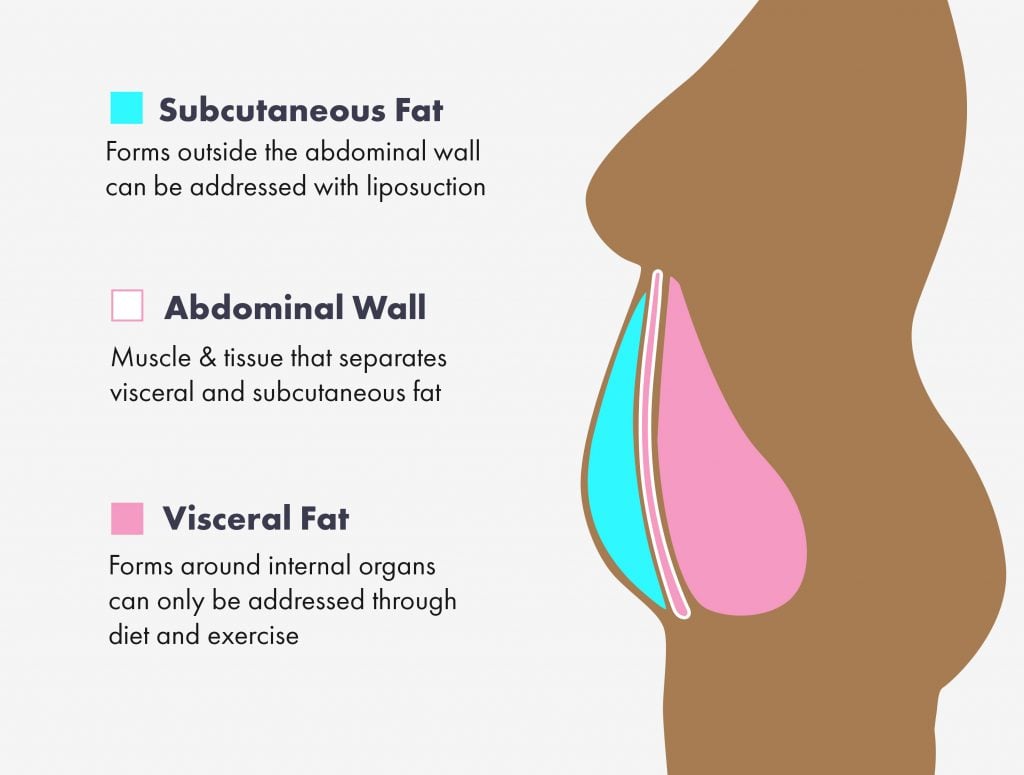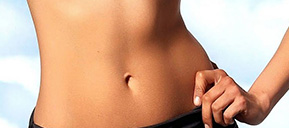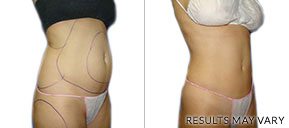1. Not All Fat is Created Equal
There are two types of fat that are especially important when we’re talking about stomach liposuction: subcutaneous fat and visceral fat.
Subcutaneous fat is the jiggly, pinchable fat located just underneath the skin. It’s generally harmless, but aesthetically it can be undesirable. Visceral fat is stored inside the abdominal cavity. Visually, it can be identified as the typical “beer belly” – it’s firm and hard, and people with a lot of visceral fat are sometimes referred to as “skinny-fat.” It’s also much worse for your overall health than subcutaneous fat. All fat cells release hormones, but because visceral fat is stored next to your organs, it’s more likely to interfere with organ functions, which can lead to greater insulin resistance (type 2 diabetes), higher blood pressure, higher bad cholesterol (LDL) levels in your blood stream, and increase risk for heart disease and stroke.

Stomach liposuction can only remove subcutaneous fat. Visceral fat is firmly embedded inside the abdominal cavity – it cannot be suctioned out. Weight Loss through diet and exercise can reduce visceral fat safely and effectively.

Having a lot of visceral fat won’t necessarily prevent you from having liposuction, but it will affect the kind of results you can expect from the procedure. The above patient had liposuction of the abdomen as well as waist and hips. We can see clear results, and this patient was very satisfied. However, we can see that the stomach area still has a bit of fullness – that’s from visceral fat, which liposuction can’t address.
Without an MRI or CAT scan, you can’t tell exactly how much visceral fat you have, but there are some general guidelines.
Typically, visceral fat is about 10% of your overall body fat. As a general rule, if you’re a man with a waist over 40 inches, or you’re a woman with a waist over 35 inches, then your visceral fat may start to affect your health – and if your health is poor, you may no longer be a candidate for liposuction.
In your consultation, we’ll address visceral fat, whether you’re a candidate for stomach liposuction, and talk about the kind of results you can expect from the procedure.
2. Stomach Liposuction Doesn’t Require General Anesthesia
This is true for all body areas, but it didn’t used to be the case! In fact, there are still surgeons who prefer the old method using general anesthesia, especially when we’re talking about the abdomen. Whether your surgeon is using general anesthesia or local anesthesia only, they’ll likely use the tumescent method, which has been the gold standard for safe and effective liposuction for many years.
The tumescent method of stomach liposuction involves filling the fatty area between the skin and the abdominal cavity with what’s called tumescent fluid – a mixture of saline and epinephrine, with sodium bicarbonate as a buffer. The saline solution fills the fatty layer under the skin until it is enlarged and firm (or tumesced), making it easier to sculpt – which is why this method is sometimes called Liposculpture. The epinephrine acts as a vasoconstrictor, constricting blood vessels in the area to reduce bruising and blood loss.
If your surgeon is performing stomach liposuction using local anesthesia, they’ll also add lidocaine (a numbing agent) to the tumescent fluid. This allows surgeons to perform lipo without putting patients to sleep, and reduces the risks that come with general anesthesia, making the procedure safer overall. The tumescent method with local anesthesia is what we use here at Houston Lipo Center.
3. Beware of Loose Skin and Belly Hang
As you age, the amount of collagen your body produces decreases, which results in less skin elasticity – meaning your skin doesn’t bounce back like it used to. Now, there’s no wrong age to get liposuction! But be aware, the older you are, the more likely skin laxity may be an issue, especially with stomach lipo.
We use SmartLipo (laser-assisted liposuction) on most cases here at Houston Lipo Center because it has been shown to increase collagen production, which firms and tightens skin in the area.
You may be aware that loose skin can be a problem after extreme weight loss – it also can be an issue after liposuction. Laser-assisted liposuction like SmartLipo will give you the best possible skin-tightening results from liposuction alone. That said, there are some cases where, due to the size of the abdomen or the lack of skin elasticity, you may want to consider a tummy tuck.
Watch this video for more information on when skin laxity is an issue and when it’s not.
4. Fat Doesn’t Move Around (But You Can Still Gain Weight)
Liposuction is an investment in your body, and like any investment, it needs to be maintained. Stomach liposuction won’t prevent you from gaining back weight in your stomach, and it certainly won’t prevent you from gaining weight. If you do gain weight, your stomach will still be slimmer than it would have been otherwise! Remember, liposuction is not a weight loss solution and should not be used like one.
Stomach liposuction removes fat cells from the abdomen area – permanently. Those cells don’t come back, they don’t move around, and your body doesn’t change where it stores fat.
After stomach liposuction, your body has fewer fat cells in the abdomen than it used to (about 70% less). If you gain weight after stomach liposuction, your body stores the same amount of fat in the same places that it usually does. However, since we’ve removed a lot of fat cells in the stomach, other areas may seem larger than your stomach in comparison. Your abdomen will always be smaller than it would have been without lipo – but that doesn’t mean you can eat whatever you want and never gain weight. Again, it’s something you have to maintain – liposuction isn’t a quick fix and shouldn’t be used like one.
5. Six-pack Abs are Made in the Gym (and the Kitchen)
You’ve probably heard the term “abs are made in the kitchen, not the gym.” And there’s a lot of truth to that. If you have a lot of subcutaneous fat, it doesn’t matter how big and strong your abdominal muscles are, they’re just not going to show through.
But wait, liposuction removes subcutaneous fat, right? So why doesn’t everyone who gets liposuction have six-pack abs?
The answer is pretty simple: abs are made in both the kitchen and the gym. Or, in the case of stomach lipo, the gym and the operating room.

You probably know or have seen someone with a flat stomach. They don’t have much fat around their belly, and maybe you can see some muscle definition, but they don’t have what we’d call a six-pack. Visceral fat can also play a role – as we’ve shown previously, if you have a lot of visceral fat, you may not end up with a flat stomach from lipo. But without building strong ab muscles through exercise and weight training, you shouldn’t expect to develop abs from your lipo procedure.

With the above before-and-after photo we can see the results from a stomach liposuction case where we can really see some well-defined abs. This patient clearly hits the gym, and trains his obliques. So, although someone you know might be blessed with a naturally flat stomach, no one’s born with a natural six-pack – they’re made in the gym as much as they are in the OR.




